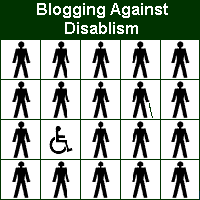 Reminder: Blogging Against Disablism Day is coming up on May 1. Diary of a Goldfish has hosted BADD since 2006. It’s an awesome blogswarm, and it’s this Saturday. You can participate by spreading the word, making your own post, commenting on people’s posts, and/or linking posts for others.
Reminder: Blogging Against Disablism Day is coming up on May 1. Diary of a Goldfish has hosted BADD since 2006. It’s an awesome blogswarm, and it’s this Saturday. You can participate by spreading the word, making your own post, commenting on people’s posts, and/or linking posts for others.
Remembering and Commemorating a Complicated Past [Nellie McClung supported Eugenics in Canada, specifically the sterilization of undesirables.]
White continues in his article to discuss some of the basic historic contours of eugenics in Canada, noting briefly that Tommy Douglas – the social democratic father of Medicare – was a proponent, and sterilization was made provincial policy in Alberta and British Columbia. There was a long and brutal history of eugenics in Canada, with patients being sterilized without their knowledge. For example, in Alberta, Leilani Muir received appendix surgery in 1959 and was sterilized without her knowledge, a fact that she discovered only years later when she was unable to conceive. It wasn’t until 1996 that she was able to achieve some justice, setting the path for many other victims to settle with the provincial government.
In my own teaching this year, I found eugenics a tricky subject to tackle.We had a great debate in our tutorial. The prevailing view was that eugenics was ‘fascist,’ thanks to an article we had read that week on Nazi reproductive policies. Thanks to the memory of the Second World War, this is the popular memory, and was instrumental in dismantling many forced sterilization and eugenics programs after it all came to light. Yet once I began bringing up the history of eugenics in Canada, from Tommy Douglas to Leilani Muir, one student gutsily argued that eugenics was ‘progressive’ for the time, with respects to public health, poverty, etc. It was an uncomfortable discussion, to be sure, when speaking of these devastating policies that had such an impact on people’s reproductive rights and privileges. But these are the same questions that must vex people as they ponder whether to honour somebody like Nellie McClung. At the time, how common were her views? Ought she to know that they were wrong?
Anderson uses a number of typographical and structural tricks in this book—crossed out words, chapter numbers counting down, and others I won’t spoil by revealing— and they’re all there for a reason and they all work. The supporting characters, unusually for a novel which is so firmly set within the point of view of a character being sucked into a solipsistic state of mental illness, are sharply believable and non-stereotypical despite those constraints. (Since I know everyone who’s already read the book will be wondering, yes, I did indeed loathe the “free-spirited nonconformist” guy she gets involved with, but thankfully Anderson did not represent him as the undiluted essence of awesome that I dreaded the moment he launched into his defense of mooching food from other diners’ plates.)
President Obama: A Transgender Veteran Is Not An ”Impersonator,” ”It,” Or ”Shim”
Dear President Barack Obama,
My name is Autumn Sandeen, I’m a retired, disabled Fire Controlman, First Class Petty Officer; I retired in 2000 from the U.S. Navy after twenty years of service. You may know my name already, as I was one of the six military veterans who handcuffed ourselves to the White House fence on Tuesday, April 20th, 2010, to put pressure on you to include the repeal of Don’t Ask, Don’t Tell in your submission of the Defense Authorization Budget. I am writing today to bring to your attention the discriminatory behavior I was subjected to as a transgender woman by your federal law enforcement officers.
Dreamwidth has a new community: Disabled Rage
This is a community for all of us with disabilities to rage about the overwhelming ableist bullshit in the world around us. It’s a place to vent our anger and frustration with the inaccessibility, the condescension, the ignorance, the mistreatment – in short, the rage-making things we’re forced to fight every day.
This is a rage community. We like anger. We think it’s healthy and happy to be angry. Rage is most effective when it stays more or less on target, though, and to that end, the comm has a few guidelines.
fter missing last week’s episode of Parenthood, I watched this week, only to be annoyed and un-entertained again. More “woe is me, I have an autistic child” dramatizing, more cliches and sappiness.
But I have to admit that I was personally hoping that Sydney would turn out to be on the spectrum, too.
Why? Well, because having more than one autistic character in one work shows audiences that not all autistic people are alike–including those who share an “Asperger’s” designation. It also helps to avoid stereotypes, as perhaps writers won’t feel compelled to shoe-horn every single autistic trait into one character, as so many do. I actually think the Parenthood writers have been doing a fairly good job in presenting a believable character so far, but it can’t hurt to have another character. And a girl! Girls and women on the spectrum are so rarely represented and I was kind of hoping there’d be a concrete example. Alas, no.
Like a woman after her insurance benefits.
Last week I was told my insurance company wouldn’t cover any more PT sessions.
However I could pay out of pocket and could continue to be treated.
The verdict that was reached that my PT would try to talk to the insurance company personally and rewrite the progress note. There’s no point to pay for something out of pocket that I’m already paying an insurance company to pay for. It’d be like paying for the same thing twice, actually it is.
Susan recommends a BBC radio programme about language & disability that is available online till next Tuesday. I know I can access BBC radio programmes in Canada, so I assume they’re available everywhere if your computer/download limit can handle them.
Hot Pieces of Ace is a new asexual youtube channel.
Ontarians! The Law Commission of Ontario is at the Consultation Stage regarding how the new accessibility laws will be implemented. There are focus groups!
Has your country ratified the UN Rights and Dignity of Persons with Disabilities? Or has it, like mine, only agreed with parts of it?

